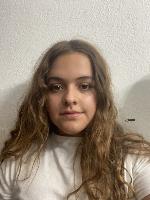

dB-BLUE: A Bracelet to Prevent Sound Stress in Autistic Children |
Participate and share : Poster
Valentina María Huerta Ramírez Isabella Guzmán Rodríguez Mirandaa Aguilar Ruiz Estefania Solis Valeria Díaz Isaac Yair Gonzalez Baron
Learn how seventh-graders followed design thinking and problem-based learning to create a bracelet that prevents sound stress reactions in autistic children.
| Audience: | Principals/head teachers, Teachers, Technology coordinators/facilitators |
| Skill level: | Beginner |
| Attendee devices: | Devices useful |
| Attendee device specification: | Smartphone: Android, iOS, Windows Laptop: Chromebook, Mac, PC Tablet: Android, iOS, Windows |
| Topic: | Equity & inclusion |
| Grade level: | 6-8 |
| Subject area: | Computer science, STEM/STEAM |
| ISTE Standards: | For Students: Innovative Designer
|
| Additional detail: | Student presentation |
Adverse reactions to noise and other forms of sensory input (sensory processing disorders) are common in children with autism. A wide range of noise categories such as sirens and whistles, bells, machinery noise, air hand dryers, unexpected sudden noises and the general din created by many people talking (crowd noise) produce adverse effects and reactions in children with autism. Although these can vary and are individual, sudden or strong noises can produce agitation, screaming, groaning, putting their hands over their ears, or in more severe cases, cause an epileptic crisis.
Sadly, avoiding noise altogether is not a viable option for autistic children since noise is ubiquitous and pervades most aspects of a kid´s daily life, including the classroom. Therefore, coming up with a creative solution to help these children monitor noise level and alert them before they reach a certain volume threshold that could activate adverse responses, is not only helpful but necessary.
Join this session to discover how Highlands International School Mexico 7th grade students developed a bracelet to warn autistic children when noise around them is getting too loud and could trigger an adverse response due to their sound hipersensibility. . Students followed Design Thinking throughout this project. First they had to research about autism to empathize with the problems these children usually face when interacting with society. Later on, after working in a cooperative inquiry they began to define the problem: Loud noises make them feel stressed. As soon as they clarified the problem they used brain storming to ideate their product. They used TinkerCad to design and create their prototype. They programed an Arduino Nano and added it to their bracelet so it could sense loud noises and warn autistic children about them by the activation of a small light on the bracelet. Students named their Product dB.BLUE as blue is the color associated with autism awareness.
The Main Purposes and Objectives of this project are:
- To share with the audience how Design Thinking and technology were successfully used to address a real life proble: sound hipersensibility in autistic children.
- To give students an international platform to share with the audience the process they followed, the challenges they faced and the final product they created to help autistic children prevent adverse response to noise level.
• Gomes, Erissandra, Rotta, Newra T., Pedroso, Fleming S., Sleifer, Pricila, & Danesi, Marlene C.. (2004). Auditory hypersensitivity in children and teenagers with autistic spectrum disorder. Arquivos de Neuro-Psiquiatria, 62(3b), 797-801. https://doi.org/10.1590/S0004-282X2004000500011
• Müller-Roterberg, Christian. (2018). Handbook of Design Thinking.
• Sequeira, Eldrid. (2020). 3D printing and maker lab for kids: create amazing projects with CAD design and STEAM ideas
• https://austinpublishinggroup.com/neurological-disorders-epilepsy/fulltext/ajnde-v2-id1009.php
• https://drive.google.com/file/d/1N3Cw--oj5GBAwKYf0m1StKm6lc4mZDhD/view?usp=sharing
- https://austinpublishinggroup.com/neurological-disorders-epilepsy/fulltext/ajnde-v2-id1009.php






Painani, Delivering Messages to Enhance Blended Learning
Sunday Mainstage
Teach AI With Student-Driven Activities for Every Classroom